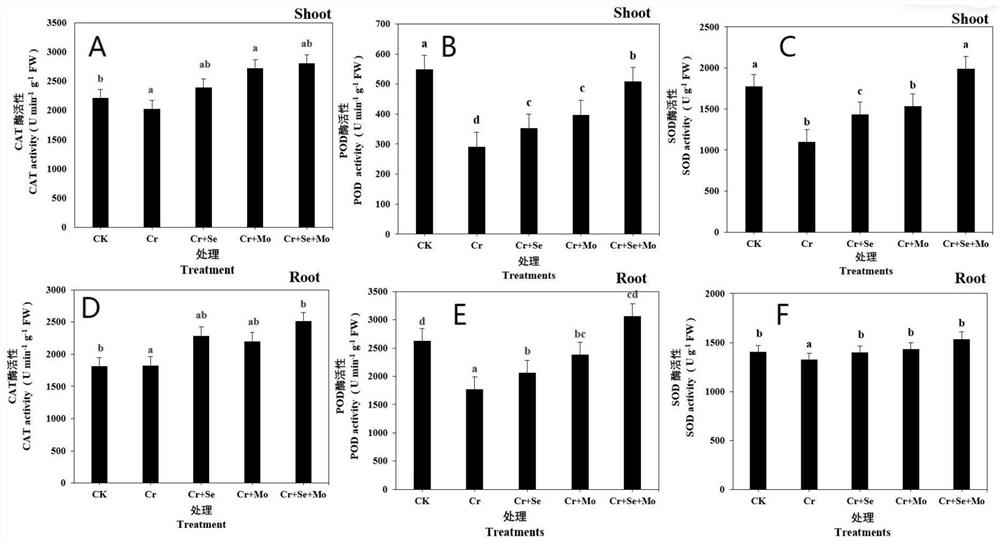Application of exogenous selenium-molybdenum composition in alleviating chromium stress in tobacco
A technology of exogenous selenium and composition, applied in the field of agriculture, can solve problems such as harming the health of smokers, unclear mechanism, and threat to the safety of cigarette products, so as to improve the antioxidant system, alleviate the inhibition of photosynthesis, and enhance the resistance to heavy metal stress effect of ability
- Summary
- Abstract
- Description
- Claims
- Application Information
AI Technical Summary
Problems solved by technology
Method used
Image
Examples
Embodiment approach
[0033] Selection of raw materials: Tobacco variety Yunyan 87, which is widely grown in the country, was selected. Chromium is potassium dichromate with a concentration of 50 μmol / L.
[0034] Source of reagents: Sodium selenite, sodium molybdate, potassium dichromate solid powder were purchased from Zhengzhou Aikemu Chemical Co., Ltd., analytically pure reagents with a content of 99%.
[0035] Cultivation method: (1) Pretreatment of tobacco seeds: first disinfect with 10% sodium hypochlorite solution for ten minutes, then rinse with ultrapure deionized water, and soak the seeds for 8 hours; In the deionized water seedling tray of the grid sponge, 2-3 seeds per grid point, and then placed in an incubator at 28°C for germination in the dark; (3) About three weeks after the seeds germinate, use tweezers to germinate them. Tobacco seedlings with 2 cotyledons were transplanted into commercially available vermiculite boxes (the chemical composition of vermiculite is SiO 2 Al 2 O ...
Embodiment 1
[0050] The effect of the application of exogenous selenium and molybdenum composition on the biomass of tobacco seedlings under chromium stress, see for details figure 1 . The plant height, root length, leaf dry weight and root dry weight of the above five groups of tobacco seedlings were measured by the above-mentioned methods of agronomic traits and biomass determination and fresh weight of each part of tobacco samples.
[0051] Depend on figure 1 It can be seen that Cr stress significantly reduced plant height, root length, leaf dry weight and root dry weight, while the use of Se, Mo and Se+Mo all alleviated the inhibitory effect of Cr on the growth of tobacco seedlings. Compared with CK, the Cr treatment significantly decreased plant height and root length by 16.8% and 42.6%, and leaf dry weight and root dry weight of tobacco seedlings decreased by 28.0% and 38.9%, respectively. The addition of Se and Mo significantly promoted the growth of tobacco seedlings under chromi...
Embodiment 2
[0054] The effect of the application of exogenous selenium and molybdenum composition on the chlorophyll content in tobacco seedlings under Cr stress, see for details figure 2 . Using the above-mentioned physiological and biochemical assay methods, the chlorophyll content of the tobaccos of the above five groups was measured respectively.
[0055] Photosynthesis and other physiological processes are highly sensitive to heavy metals, and low concentrations of Cr can also inhibit photosynthesis in plants. like figure 2 As shown, chromium stress significantly reduced the chlorophyll content of tobacco seedlings by 41.0%, 30%, and 38%, respectively. Studies have shown that the addition of selenium and molybdenum alone can increase the content of chlorophyll under chromium stress. The addition of Se and Mo significantly increased the content of chlorophyll a by 26.7% and 36.2%, and the content of chlorophyll b by 34.7% and 101.1%, respectively. The content of T was significant...
PUM
 Login to View More
Login to View More Abstract
Description
Claims
Application Information
 Login to View More
Login to View More - R&D Engineer
- R&D Manager
- IP Professional
- Industry Leading Data Capabilities
- Powerful AI technology
- Patent DNA Extraction
Browse by: Latest US Patents, China's latest patents, Technical Efficacy Thesaurus, Application Domain, Technology Topic, Popular Technical Reports.
© 2024 PatSnap. All rights reserved.Legal|Privacy policy|Modern Slavery Act Transparency Statement|Sitemap|About US| Contact US: help@patsnap.com










